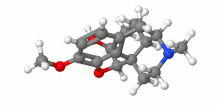This article may require cleanup to meet Wikipedia's quality standards. The specific problem is: significant portions of unreferenced, vague or incorrect information. Additionally, the areas that are cited are highly inappropriate citations. (August 2014) |
 | |
 | |
| Clinical data | |
|---|---|
| Other names | 6α-Hydrocodol[1] |
| AHFS/Drugs.com | International Drug Names |
| Dependence liability | High |
| Addiction liability | High |
| Routes of administration | |
| ATC code | |
| Legal status | |
| Legal status |
|
| Pharmacokinetic data | |
| Bioavailability | By mouth: 21% (range 12–34%)[3] |
| Metabolism | |
| Metabolites | • Dihydromorphine • Nordihydrocodeine • Others (e.g., conjugates) |
| Elimination half-life | 4 hours[3] |
| Identifiers | |
| |
| CAS Number | |
| PubChem CID | |
| IUPHAR/BPS | |
| DrugBank | |
| ChemSpider | |
| UNII | |
| KEGG | |
| ChEMBL | |
| CompTox Dashboard (EPA) | |
| ECHA InfoCard | 100.004.303 |
| Chemical and physical data | |
| Formula | C18H23NO3 |
| Molar mass | 301.386 g·mol−1 |
| 3D model (JSmol) | |
| |
| |
| | |
Dihydrocodeine is a semi-synthetic opioid analgesic prescribed for pain or severe dyspnea, or as an antitussive, either alone or compounded with paracetamol (acetaminophen) (as in co-dydramol) or aspirin. It was developed in Germany in 1908 and first marketed in 1911.[4]
Commonly available as tablets, solutions, elixirs, and other oral forms, dihydrocodeine is also available in some countries as an injectable solution for deep subcutaneous and intra-muscular administration. As with codeine, intravenous administration should be avoided, as it could result in anaphylaxis and life-threatening pulmonary edema. In the past, dihydrocodeine suppositories were used. Dihydrocodeine is available in suppository form on prescription. Dihydrocodeine is used as an alternative to codeine.
It was first described in 1911 and approved for medical use in 1948.[5] Dihydrocodeine was developed during the search for more effective cough medication, especially to help reduce the spread of tuberculosis, pertussis, and pneumonia in the years from c.a. 1895 to 1915. It is similar in chemical structure to codeine. Dihydrocodeine is twice as strong as codeine.[6] Although dihydrocodeine does have extremely active metabolites, in the form of dihydromorphine and dihydromorphine-6-glucuronide (one hundred times more potent), these metabolites are produced in such small amounts that they do not have clinically significant effects.[7]
Dihydrocodeine is also the original member and chemical base of a number of similar semi-synthetic opioids such as acetyldihydrocodeine, dihydrocodeinone enol acetate, dihydroisocodeine, nicocodeine, and nicodicodeine.
- ^ Karch SB (9 October 2007). Pharmacokinetics and Pharmacodynamics of Abused Drugs. CRC Press. pp. 56–. ISBN 978-1-4200-5460-6.
- ^ Anvisa (2023-03-31). "RDC Nº 784 – Listas de Substâncias Entorpecentes, Psicotrópicas, Precursoras e Outras sob Controle Especial" [Collegiate Board Resolution No. 784 – Lists of Narcotic, Psychotropic, Precursor, and Other Substances under Special Control] (in Brazilian Portuguese). Diário Oficial da União (published 2023-04-04). Archived from the original on 2023-08-03. Retrieved 2023-08-03.
- ^ a b Rowell FJ, Seymour RA, Rawlins MD (1983). "Pharmacokinetics of intravenous and oral dihydrocodeine and its acid metabolites". European Journal of Clinical Pharmacology. 25 (3): 419–424. doi:10.1007/BF01037958. PMID 6628531. S2CID 29370394.
- ^ Stolerman I (31 July 2010). Encyclopedia of Psychopharmacology. Springer Science & Business Media. ISBN 9783540686989.
- ^ Fischer J, Ganellin CR (2006). Analogue-based Drug Discovery. John Wiley & Sons. p. 52X. ISBN 9783527607495.
- ^ "Equivalence table (in French)" (PDF). Archived from the original (PDF) on 1 February 2013. Retrieved 12 April 2018.
- ^ Schmidt H, Vormfelde SV, Walchner-Bonjean M, Klinder K, Freudenthaler S, Gleiter CH, et al. (March 2003). "The role of active metabolites in dihydrocodeine effects". International Journal of Clinical Pharmacology and Therapeutics. 41 (3): 95–106. doi:10.5414/cpp41095. PMID 12665158.